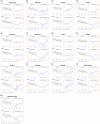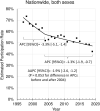Trend of estimated participation rate by regional block, gender, and age group in the 1997-2019: National Health and Nutrition Survey in Japan
- PMID: 38478512
- PMCID: PMC10936830
- DOI: 10.1371/journal.pone.0286169
Trend of estimated participation rate by regional block, gender, and age group in the 1997-2019: National Health and Nutrition Survey in Japan
Abstract
This study aimed to identify the trend of approximate participation rate in Japan's National Health and Nutrition Survey (NHNS_J). The proportion of participants among all residents of surveyed districts (estimated participation rate: EPR) was calculated by 12 regional blocks, gender, and age group, and the trend and annual percent change (APC) were clarified. Based on the 1997-2019 NHNS_J data, we created a database classified by prefecture, gender, and age group; in addition to these, the number of people per household by Population Census or population estimates were obtained from e-Stat and added to the database. All analyses were performed by regional block and gender and EPR for each year was calculated by the age group. Trends of EPR, overall and by the age group, were presented using graphs, illustrating the exponential regression curve. The graphs showed APC, standard error, and statistical significance by age group. The EPRs were declining in all the regional blocks. Additionally, the rates of decline in APC in young people under the age of 50 years were higher than those in the older age groups in 9 of 12 regional blocks. The nationwide APC in the age group <50 years was significantly larger than that in the age group ≥50 years. The declining EPR trend in NHNS_J in all regional blocks (especially among younger people) suggests the need for a strategy to improve participation rates in the future.
Copyright: © 2024 Ishikawa et al. This is an open access article distributed under the terms of the Creative Commons Attribution License, which permits unrestricted use, distribution, and reproduction in any medium, provided the original author and source are credited.
Conflict of interest statement
The authors have declared that no competing interests exist.
Figures





Similar articles
-
[Key variable combinations for identifying non-participants in the Japan National Health and Nutrition Survey through record linkage with the Comprehensive Survey of Living Conditions].Nihon Koshu Eisei Zasshi. 2019;66(4):210-218. doi: 10.11236/jph.66.4_210. Nihon Koshu Eisei Zasshi. 2019. PMID: 31061277 Japanese.
-
[A cross-sectional study of the association between city scale and daily steps in Japan: Data from the National Health and Nutrition Survey Japan (NHNS-J) 2006-2010].Nihon Koshu Eisei Zasshi. 2016;63(9):549-559. doi: 10.11236/jph.63.9_549. Nihon Koshu Eisei Zasshi. 2016. PMID: 27818468 Japanese.
-
Italian cancer figures, report 2012: Cancer in children and adolescents.Epidemiol Prev. 2013 Jan-Feb;37(1 Suppl 1):1-225. Epidemiol Prev. 2013. PMID: 23585445 English, Italian.
-
[SENTIERI - Epidemiological Study of Residents in National Priority Contaminated Sites. Sixth Report].Epidemiol Prev. 2023 Jan-Apr;47(1-2 Suppl 1):1-286. doi: 10.19191/EP23.1-2-S1.003. Epidemiol Prev. 2023. PMID: 36825373 Italian.
-
[Mortality Atlas of the Campania Region. All-cause and cause-specific mortality at municipal level, 2006-2014].Epidemiol Prev. 2020 Jan-Feb;44(1 Suppl 1):1-144. doi: 10.19191/EP20.1.S1.P001.003. Epidemiol Prev. 2020. PMID: 33565290 Review. Italian.
Cited by
-
Efforts and systems by local governments to improve participation rates in national and local health and nutrition surveys in Japan: Findings from a workshop 2019-2024.PLoS One. 2025 Mar 3;20(3):e0314798. doi: 10.1371/journal.pone.0314798. eCollection 2025. PLoS One. 2025. PMID: 40029849 Free PMC article.
-
School Lunch and Body Size in Japanese Junior High School Students: The Japanese National Health and Nutrition Survey.Nutrients. 2025 Mar 3;17(5):895. doi: 10.3390/nu17050895. Nutrients. 2025. PMID: 40077765 Free PMC article.
-
Dietary greenhouse gas emissions and resource use among Bavarian adults: associations with sociodemographics and food choices.Front Nutr. 2025 Apr 9;12:1542254. doi: 10.3389/fnut.2025.1542254. eCollection 2025. Front Nutr. 2025. PMID: 40271426 Free PMC article.
References
-
- Ministry of Health, Labour and Welfare. National health and nutrition survey. https://www.mhlw.go.jp/bunya/kenkou/kenkou_eiyou_chousa.html (in Japanese)
-
- Ministry of Health, Labour and Welfare. A basic direction for comprehensive implementation of national health promotion. 2012. https://www.mhlw.go.jp/file/06-Seisakujouhou-10900000-Kenkoukyoku/000004...
-
- Ministry of Health, Labour and Welfare. Health Japan 21 second, midterm evaluation. https://www.nibiohn.go.jp/eiken/kenkounippon21/en/kenkounippon21/index.html
-
- Nishi N, Nakade M, Sarukura K, Nozue M, Tsubota M, Miyoshi M, et al.. Participation rate and related factors of National Health and Nutrition Survey. Kousei Shihyo. 2012;59: 10–15. (in Japanese)
MeSH terms
LinkOut - more resources
Full Text Sources
Miscellaneous

